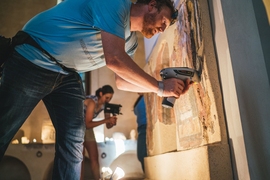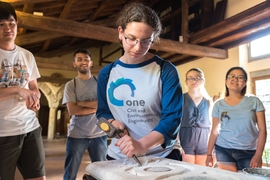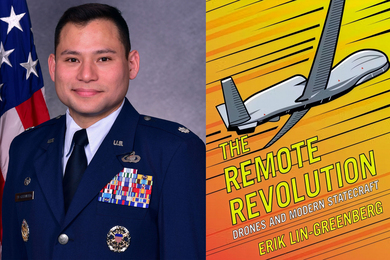Remnants of ancient Roman structures withstand centuries of wear and warfare across Europe, recording the history and culture of the people who lived around them. But hidden within mortar, and hinted by delicate cracks and chips, the structures record something else that could improve how similar materials are built today: ancient engineering.
For the fourth summer in a row, 16 rising sophomores visited civilization-spanning structures and monuments in Italy through the Department of Civil and Environmental Engineering’s ONE-MA3 program, which integrates the study of art, architecture, and archaeology. During the three-week field course, which is supported by the AREA3 Association (Associazione per la Ricerca e l'Educazione nell'Arte, Archeologia e Architettura), students conducted research on ancient artifacts and structural materials to inspire new research projects grounded in time, which they explore further in the fall semester in 1.057 (Heritage Science and Technology).
Admir Masic, the Esther and Harold E. Edgerton Assistant Professor of Civil and Environmental Engineering who leads the program, says, “Bringing students into the field is the easiest way to stimulate their curiosity.” Along with CEE, Masic is also an archaeological materials faculty fellow for the Department of Materials Science and Engineering (DMSE) at the Center for Materials Research in Archaeology and Ethnology (CMRAE). In his research, Masic and his team apply principles of chemistry and materials science to characterize and organize human-made materials used both in the past and at present.
ONE-MA3 “offers students a hands-on experience to learn about how materials are the backbone of infrastructure, and how the field has evolved over thousands of years,” says McAfee Professor of Engineering and CEE department head Markus Buehler. Buehler considers the summer program a quintessential MIT experience — by studying ancient construction materials in the field, students are able to connect theoretical concepts to practical settings, and can begin to tackle modern issues in construction.
Constructing sustainable structures
One material, Roman concrete, served as the foundation for the course. Unlike the quick-to-disintegrate, weather-sensitive and pothole-prone concrete used to construct roads and highways today, Roman concrete hardens and repairs itself in the presence of water.
Conventional modern concrete is usually composed of three materials: water, rock, and cement. However, that formula is deceptively simple: The specific compositions of those materials can make or break the resulting structure. In the case of Roman concrete, those specific compositions are not well understood, only archived in the structures themselves.
“Understanding the reasons behind the resilience of Roman concrete could pave new paths,” says Janille Maragh, a graduate student and three-time teaching assistant for the program who worked alongside graduate student Linda Seymour. “It’s one thing to do research using cultural heritage data, but without context, it’s difficult to grasp the magnitude of the problem.”
To kick off the summer program, students gathered at the castle in Sermoneta, a historical village located in the Italian countryside. There, they learned about the significance of lime, a key ingredient in Roman concrete, and they tried their hand at composing Roman concrete using different aggregates such as pozzolana (volcanic ash), cocciopesto (ground clay bricks), and pumice under the instruction of local guest lecturers. The aggregates studied were readily present in different environmental and volcanic settings in ancient Rome, and don’t require a carbon emission-heavy industrial process to create, unlike aggregates and materials used in modern concrete today.
One main goal of this specific exercise, and the program in general, is to elicit creative and advanced ways to engineer new materials and technologies. Through experimentation with different materials, proportions, and compression testing of the resulting samples and structures, students learned first-hand the challenges behind creating mortars that are both durable and sustainable. They presented the reasoning behind their chosen compositions to their peers ahead of their next lessons.
Traveling time
Reflecting the Institute’s motto, "mens et manus" ("mind and hand"), Masic led students on excursions to various historical and archeological sites around Italy to give students the opportunity to interact with different materials, examine their uses first-hand, and contemplate the cultural significance of ancient structures and the materials that built them. Through lectures and field exercises, students studied the chemical makeup, historical significance, and conservation methods of preserved structures in order to set the stage for future engineers to build structures that last and positively impact society.
“My hope for ONE-MA3 is that this experience will allow participants to grow as humans and as students,” Masic says. “The program allows students to view our modern world with a completely new perspective.”
By using ancient Roman materials as the building blocks for modern structures in the presence of architectural and structural paragons, students were exposed to a learning opportunity not available in the classrooms of Cambridge, Massachusetts.
Sophomore Anna Landler, a student who participated in the 2019 iteration of ONE-MA3, says the program helped her grasp concepts crucial to civil and environmental engineering that would take months to understand in the classroom. “Being out in the field, where we were able to see and feel these objects, helps me understand them better and know how they interact with the world around us … I wouldn’t be nearly as inspired as I would be if it was in a lecture format or a textbook.”
In addition to studying ancient technologies, students learned about restoration, the practice of best preserving artifacts. In a tour of the Vatican museum, students heard from Guy Devreux, the head of the museum’s laboratory for stone conservation, as he described and showed them behind-the-scenes restoration of marble sculptures. Sophomore Sophia Mittman, a student majoring in materials science and engineering, says the experience enhanced her passion for conservation. “Everything we learned came alive right in front of us, whether it was producing 3-D models of structures and statues … It is an incredible way to learn from ancient technologies and discover how they can be adapted and applied to modern technology today,” states Mittman.
The students also visited Pompeii — the ancient city buried by four to six meters of volcanic ash due to the eruption of Mount Vesuvius in 79 A.D. Excavations at Pompeii offer archeologists a glimpse into Roman life, freezing people and their environments in time. There, students were presented with a pressing issue: No one knows how to effectively preserve Pompeii and its ruins. They also explored the American Academy in Rome with the Director and MIT Professor John Ochsendorf, where they examined significant ancient texts, such as Galileo Galilei’s original works and the first edition of the Italian copy of Vitruvius.
Motivated by a newfound passion for cultural heritage, students next studied photogrammetry for 3-D modeling in an effort to digitally document and preserve museum artifacts and structures. “I think there is an intriguing combination between using digital arts and media in order to explain these engineering concepts to those who may not understand it as well, or don’t have the kind of opportunity to meet with experts and professors, it is definitely important to reach youth around the world and encourage them. I felt that I have been able to explore my interests during the program, and it has allowed me to ask questions and grow a lot,” says sophomore Ben Bartschi.
Looking forward
After exploring the extravagant baroque palaces in Turin, the students made their way to the Egyptian Museum, Museo Egizio, where they had the opportunity to go behind the scenes and investigate ancient Egyptian artifacts, roughly 3,000 years old. They used non-invasive characterization tools to study and collect data on the centuries-old materials. They also learned about the fascinating Egyptian Blue pigment, invented 5,000 years ago, which continues to be used in modern science and technology today.
“The fact that we are dedicating so much time to ourselves to engage in this process makes us realize the amount of time, care, and importance of conservation,” Landler says. Without visiting and studying ancient materials, structures, and cultural artifacts in their environments, “you don’t really understand the labor that goes into this job.”
With each iteration of the program, ONE-MA3 students learn the significance of looking into the past to inspire innovation today, and the imperative cultural heritage enabled and preserved due to feats of civil, environmental, and material engineering. Many, including Masic, are excited to see the acquired knowledge applied as students begin the new academic year.
“Advancement lies at the interface of various disciplines,” says Masic. “To be able to innovate, we need to observe and challenge many different perspectives. When it comes to ancient technologies, this holds true as well: It’s a great avenue for innovation, and we hope to translate that into inspiration for modern materials and structures.”
Contributors to ONE-MA3 include: Restorer and art conservator Roberto Scalesse from the Società Erresse, IT specialist Gianfranco Quaranta from the Artech Laboratories srl, chemist and conservation scientist Marco Nicola from the Adamantio srl and the University of Turin, professor of archaeology and ancient technology Dorothy Hosler from the Department of Materials Science and Engineering at MIT, Duncan Keenan-Jones from University of Queensland, Christian Greco and Enrico Ferraris from the Museo Egizio, Guy Devreux from the Musei Vaticani, Tommaso Agnoni from the Roffredo Caetani Foundation, Francesco Di Mario from the Soprintendenza Archeologia and Belle Arti e Paesaggio per le Provincie di Frosinone and Latina e Rieti, Lisa Accurti from the Soprintendenza Archeologia Belle Arti e Paesaggio Città Metropolitana di Torino, Bruno de Nigris and Massimo Osanna from the Parco Archeologico di Pompei, Mastro Gilberto Quarneti, Gianni Nerobutto from the Calchèra San Giorgio, Alessandro and Gian Luigi Nicola from the Nicola Restauri srl, Mauro Volpiano and Claudia Cassatella from the Politecnico di Torino, Riccardo Antonino from Società Robin and Politecnico di Torino, Stefano Trucco and Anna Piccirillo from the Centro per la Conservazione e Restauro “La Venaria Reale,” Dario Parigi from the Aalborg University, Michal Ganobjak from the Federal Laboratories for Materials Science and Technology, Chiara Mastreopolito, Alessandro Marello and Alessandro Bazzacco from the Adamantio srl, Piercarlo Innico from the Associazione Acropolis, Giuseppe Donnaloia from Società CACO3, Franco Vitelli from Società Sectilia, and freelancers Michele Sinisi, Claudia Rivoli, Francesca Mancinelli, and Livio Secco.












